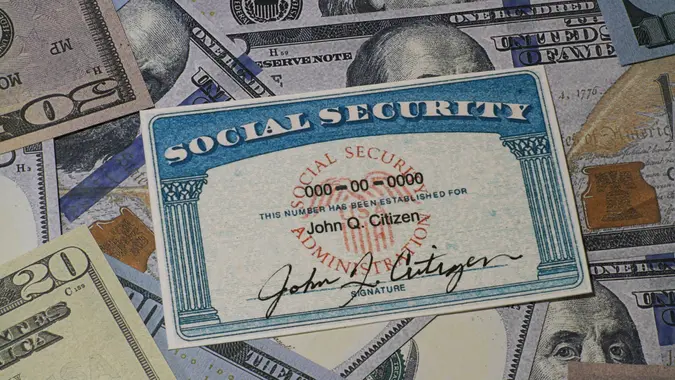3 Ways Inflation Is Impacting Seniors Living on Social Security

Commitment to Our Readers
GOBankingRates' editorial team is committed to bringing you unbiased reviews and information. We use data-driven methodologies to evaluate financial products and services - our reviews and ratings are not influenced by advertisers. You can read more about our editorial guidelines and our products and services review methodology.

20 Years
Helping You Live Richer

Reviewed
by Experts

Trusted by
Millions of Readers
Over the past few years, high inflation has complicated the finances of many Americans — particularly seniors.
In fact, retirees’ top concern is inflation reducing the value of their assets, according to a Schroders survey. Plus, nearly half of retirees say their expenses in retirement are more than they expected.
So, as prices continue to rise, many seniors have not been able to keep up — especially those living on Social Security and very little else.
“Inflation impacts seniors in retirement worse than any other age group in the United States,” said Chris Orestis, president of Retirement Genius. “Once they have moved to living on a fixed income from a combination of Social Security and Medicare, the sudden rise of prices can really undermine what they had planned for once they stopped working.”
In particular, here are three ways inflation is impacting seniors living on Social Security. Also see ways for middle-class retirees to deal with inflation.
The Basics Are Getting Harder To Afford
Many seniors use their Social Security checks to cover necessities like housing and food. Yet inflation is raising these prices, sometimes faster than Social Security benefits or other assets are increasing.
“Basic items such as groceries, gas, prescriptions and utilities become a tough daily reminder of their shrinking purchasing power,” Orestis said.
An AARP report published in 2024 found that the proportion of Americans ages 50 and older facing food insecurity grew from 7.9% to 9.8% from 2021 to 2022, which is around when inflation really started to take off.
While grocery prices have tempered recently, necessities such as electricity continue to increase in price quickly, as the latest inflation data from the Bureau of Labor Statistics shows.
COLA Doesn’t Always Cover All the Bases
To try to offset inflation, Social Security benefits get an annual cost-of-living adjustment (COLA), based on the Consumer Price Index for Urban Wage Earners and Clerical Workers (CPI-W).
For 2024, the COLA was 3.2%; in 2023, it was 8.7%.
“Although this helps to keep up with inflation, it doesn’t mean that it will cover the rising cost of all goods,” said Jaqueline Schadeck, CEO at Golden Wealth Strategies and host of PBS show “My Money Mentors.”
“When looking at cost increases across the board, the COLA is not nearly enough to keep up with this high inflationary period,” she added.
For 2025, The Senior Citizens League projects that the COLA will be 2.66%. But because that’s based on third-quarter inflation data and doesn’t necessarily represent the exact price increases all seniors will face, it’s possible this adjustment won’t be enough next year either.
Debt Is Getting More Expensive To Carry
Inflation not only affects the prices at the register. It also coincides with higher interest rates, making it very difficult for seniors to carry debt, especially those living on Social Security who lack the flexibility to adjust to higher interest costs.
“When inflation rises, so do interest rates to try to bring prices under control,” Orestis said, “and this makes the monthly cost of debt such as mortgages, car payments, credit cards and even student loans rise. Today, there are more seniors than ever living with debt in retirement, further undermining their fixed incomes.”
Overcoming Inflationary Challenges
While these developments have put pressure on many seniors, there are ways to overcome inflation.
If you’re not retired yet, recent inflation might be a wakeup call to set yourself up to have more retirement income, rather than relying on Social Security alone.
“The biggest takeaway is that every retirement plan needs these four pillars to be successful: income, growth potential, protection and liquidity,” Schadeck said. “For many people, this means creating a pension since so many of us no longer have them from our jobs. This approach provides the growth potential needed to beat inflation and enjoy our golden years.”
If you’re already retired and can’t construct your own pension of sorts from your retirement portfolio, there are still ways to manage inflation.
“Seniors on Social Security can also look at generating some income and can earn as much as $22,300 in 2024 without it impacting their benefit,” Orestis said, “but, once you are earning more, your benefit will be subject to taxation.”
Don’t be afraid to look for help if you need it, too.
“There are also numerous assistance programs that will help seniors struggling with food insecurity, affordable housing, heating and electric utilities assistance, transportation assistance and even discounts available only to seniors on a wide range of areas such as groceries, shopping, travel and entertainment,” he added.
Overall, focusing on the basics can help seniors handle inflation better.
Orestis said, “The key to managing a fixed-income inflation crunch is trying to earn some income if you can, being informed about benefits and services you are entitled to, and then being proactive to access them to the fullest.”
 Written by
Written by  Edited by
Edited by 

























